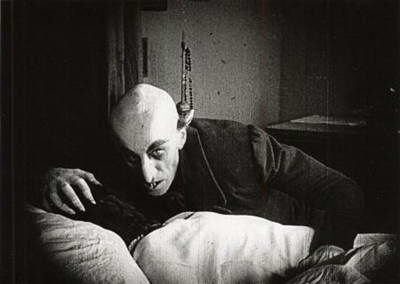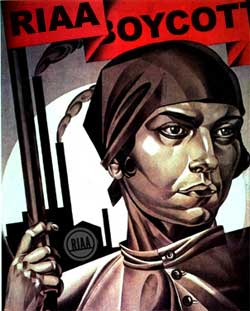
Max Schreck’s Count Orlock shares a distinction with Lon Chaney’s Phantom,
Charlie Chaplin, Buster Keaton and Rudolph Valentino — he’s an icon
from the silent era that’s still alive in the popular imagination. Kids
who couldn’t tell you the difference between John Barrymore and Lillian
Gish know Nosferatu.
Partly this is because Orlock is such a powerful icon, visually, and partly
it’s because anyone who has ever seen even the shortest clip of the
vampire in “Nosferatu” simply cannot forget it, so powerfully is Orlock
presented cinematically in the film. Orlock is the heart and soul of
the film — the part of it that inspired Murnau’s genius. Scenes
without him can be visually conventional, and the storytelling in
general can be clunky. (Murnau was still feeling his way as a
storyteller in 1922.)
The acting is very exaggerated, which suits the tale, but runs the usual
risk of highly stylized performance — if it isn’t executed brilliantly
it can seem silly. (But that’s the thrill of it, too — it’s the
thespian equivalent of trapeze flying without a net.) The young
protagonists of the tale are not terribly skillful here, and don’t seem
to have interested Murnau very much, so their expressions of marital
bliss, and later angst, can seem unconvincing, even icky. The actor who
plays Knock, however, a borderline nut-case who travels a long way
across that border in the course of the film, is sublime — he’s like a
genuinely insane person imitating a silent film actor and the result is
thrilling, funny and ghastly all at once.
The only featured player who doesn’t go over the top in the film is Max
Schreck. He moves in an exaggerated (sometimes supernatural) way, of
course, but it all seems organic — this is just Nosferatu, an
admittedly strange creature, being natural, being himself. He never
leers or threatens or grimaces — he just kills, like the Venus flytrap
or the carnivorous polyp he’s compared to visually in the film. And
there is a softness in his eyes suggesting loneliness, even shame —
qualities which Klaus Kinski exaggerated pointedly and too crudely in
Herzog’s remake of the film, to engage our sympathy. But Schreck’s
inhuman humanness wouldn’t be affecting, wouldn’t be terrifying, if he
used it to appeal to us. He’d just be a character, an actor in some
great make-up. It’s no wonder people have imagined that Schreck was a
real vampire — that’s how great and subtle his performance is.

Nosferatu incarnates the poetry of death, its cool, elegant efficiency and power,
which has a kind of awesome beauty. His face is the face we most fear
— an image of anyone, of ourselves, as a corpse — yet can’t resist
looking at. It is Murnau’s genius, and Schreck’s instinct or craft,
which let us experience the deep fascination of that face and remind us
of its familiarity. It’s one we will all have someday — and perhaps
that is why a little part of the human heart goes out to Nosferatu.

